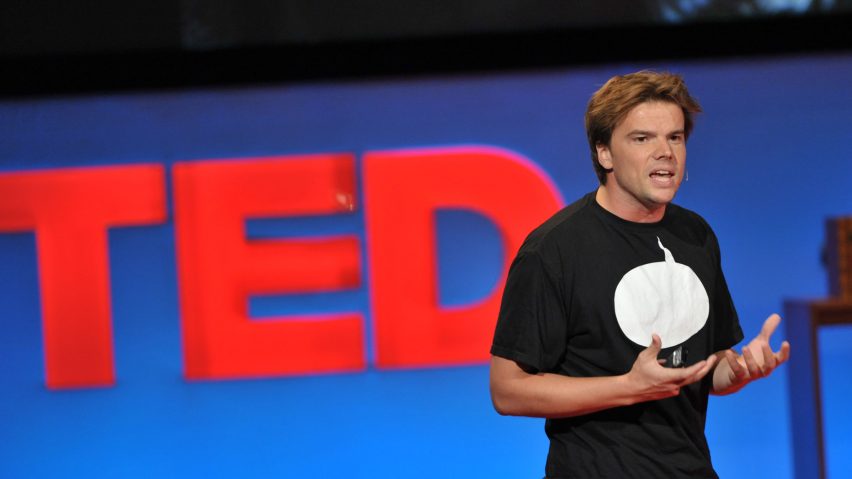The TED conference series has enabled leading thinkers, including architects, to share their ideas with the world for over 30 years. Dezeen contributing editor Jenna M McKnight has chosen some of the best presentations about the built environment from the past three decades.
In 1984, architect Richard Saul Wurman conceived of the renowned conference series that would become known as TED, which stands for Technology, Entertainment and Design.
The first event offered a sneak peak at Apple's Mac computer and a demo of Sony's compact disc, among other presentations. Six years later, in 1990, Wurman and his team hosted the second conference, which would spawn the famed, invite-only international TED conference held each year in Monterey, California.
In 2000, TED was sold to a UK media company, and in turn acquired by the nonprofit group, Sapling Foundation. The annual conference was moved to Long Beach, California, and then Vancouver.
The organisation – whose motto is Ideas Worth Spreading – also launched a series of regional conferences known as TEDx, as well as the annual $1 million TED Prize (£808,200).
Luminaries from varied disciplines have delivered TED talks, including architects such as Frank Gehry, Bjarke Ingels and Shigeru Ban. Here, we present 10 of the most intriguing talks about architecture:
UK designer Thomas Heatherwick delivered a talk in 2011 about his London-based studio's work. Featured projects include the Seed Cathedral at the 2010 Shanghai Expo, the Rolling Bridge in Paddington, and the Teesside Power Station in northern England.
Michael Murphy
American architect Michael Murphy, cofounder of the nonprofit firm MASS Design Group, promotes the healing power of architecture in this 2016 presentation. He explains how his firm has used local materials and labour to create dignified architecture in Haiti, Rwanda, Democratic Republic of the Congo, and elsewhere. He also speaks about his latest undertaking: a slavery museum and lynching memorial in the US.
Architecture photographer Iwan Baan delivered a presentation in 2013 about communities around the globe that have adapted to challenging conditions in amazing ways. He features the occupants of Torre David, the unfinished tower in Venezuela, and residents of a floating slum in Nigeria called Makoko. He also speaks about the Zabbaleen, or "garage people", in Cairo, and the underground houses that are carved out of the earth in northern China.
In this 2009 presentation, Danish architect Bjarke Ingels discusses his manifesto, Yes Is More, and the need for architects to be more earnestly engaged with the real world. Featured projects include the Danish pavilion at the 2010 Shanghai Expo and the carbon-neutral Zira Islan masterplan for Azerbaijan.
In 2013, Berlin-based architect Diébédo Francis Kéré spoke about his work in Burkina Faso, the impoverished West African country where he was raised. He explains how he uses local materials, such as clay, and the power of community to create enduring architecture in his homeland.
American architect Elizabeth Diller, cofounder of Diller Scofidio + Renfro, discusses her firm's buildings and installations in this talk from 2007. Featured topics include the Blur Building in Geneva, a pavilion made of fog; the firm's 2003 retrospective at the Whitney Museum of Art; and the re-design of Alice Tully Hall, a performing arts centre in New York.
In this vintage, 44-minute presentation from 1990, architect Frank Gehry talks in a light-hearted way about his work over the decades. Topics include the Gehry Residence, the seminal home he created in Santa Monica, California, in the late 1970s; the American Center in Paris, which was currently under construction; and his penchant for using chain-link fencing and fish symbols in his designs.
Japanese architect Shigeru Ban talks about his innovative paper tube architecture in this 2013 presentation, with a focus on emergency shelters. He has used the low-cost material to construct buildings for refugees in Rwanda and earthquake victims in Japan, among other places ravaged by war or natural disasters.
Marc Kushner
In this talk from 2014, Marc Kushner, a US-based architect and cofounder of the media site Architizer, delivers an energetic and whirlwind tour of the past 30 years of architecture. He notes how digital media has radically transformed architecture in the 21st century, as it informs and engages the public in ways never before possible.
German architect Ole Scheeren discusses the role of storytelling and collaboration in architecture, dubbed Form Follows Fiction in this 2015 presentation. Featured projects include the CCTV Tower in Beijing, the massive Interlace residential complex in Singapore, and the Collaborative Cloud office building in Berlin.

